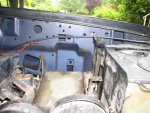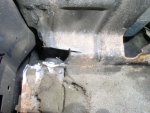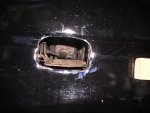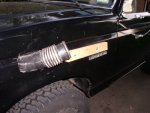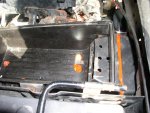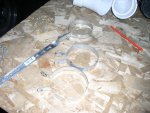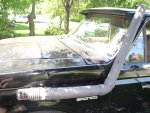yw joe,
Would it blow the diodes? probably, esp if in seawater, which I was a lot. Find a marine electrical supply site and look thru their marine alternators/starters, distribtors, etc listings and see what they advertise about being sea water friendly.
mustang distr boot pic
What about the power steering box? anything need to be done to that? Prob seal the cap too.
I know I have a Link somewhere in my site that shows a few water-"proofing" techinques.
also, somethAng typical of water problems;
Water Intrusion of Manual Lever Position (MLPS) also called Transmission Range (TR) Sensor TSB 95-2-12 for 89-94; Some vehicles may exhibit a shift concern and/or a harsh engagement concern due to water intrusion into the MLP/TR sensor and vehicle harness. There may also be a number of different DTC's along with those concerns Source: by Ford via miesk5 (Al M) at comcast.net
use dielectric grease on all your connections
swap to electric fans so you can shut them off so they dont sling water
breather tubes - put filter(s) on each end; have to find the Link w/check valves on em too later
Chis B has a pic on it and Brian
found the link;
"For our MX race trucks we do the dieletric grease-in-the-plug wire socket thing and then do the following before every race:
1. completely clean engine and wires with Superclean. Let dry. Spary wires with Wire Drier.
2. Spray wires and connectors etc with multiple coats of 'pure silicon' spray. (NOT WD-40..just aerosol silicone)
3. Spray everything down with CRC Marine Corrosion Guard...several heavy coats, allowing for some drying time in between. The stuff has a waxy tan appearance and is 'not pretty'..but then nothing is pretty after an MX dirt/mud race anyway.
No RTV or other stuff..dizzy covers ..etc required. The above combination of water-proofing prep results in an engine that runs practically underwater without the first misfire..race after race after race. And since nothing is sealed with RTV or the like, its all easily removed and cleaned up.
I should also note that we hang a sheet of fexible plastic under the radiator between the frame rails and just touching the ground, to limit some of the 'splash up' that occurs when blasting through creek crossings and the like...."
by bmc
--
my note on Silicone spray; I used it once on distr before we began sand driving; my O2 sensor went a day later! altho our 92 and up 5.0's and 5.8's, etc. O2 sensors are Supposed to be silicone tolerant...
and by Jim O
"...I see no reason not to RTV the lower distr cap to the distr.
How often does one remove a lower distr cap (never). You can even
use RTV on the upper cap. Smear an even light coating around the
top of the lip where upper cap meets the lower cap. Let it dry (before
putting on upper cap) and it now becomes a lightly pressed RTV gasket.
Many say not to, but I also RTV the vent. It'll vent through the shaft
into the engine if it really needs to and those that say you get
condensation are all wet (checked 100 times in the last 8 years,
always dry)..."
later, enjoy! and let your better half know it's all for safety ... for the family, which we both agree, comes first



